Laser Tattoo Removal
Currently, almost 30% of people in the United States have at least one tattoo, with almost half of all millennials having a tattoo. Despite the increase of tattoos, it is estimated that close to 20% of those with tattoos regret getting them in the first place. Popular reasons for tattoo removal include a negative association with the tattoo that you would like to forget, it no longer reflects who you are currently, or it has simply faded and is no longer cosmetically appealing. Unwanted tattoos are one of the most common reasons patients consult Dr. Michele Green, in her discrete Upper East Side NYC dermatology office. Patients also seek laser tattoo removal to lighten the pigment in an existing tattoo in preparation for a cover-up tattoo, or to remove of a small part of the tattoo due to an error in the design.
Before the introduction of laser tattoo removal, the only available tattoo removal methods were dermabrasion, cryosurgery, or surgical excision with plastic surgery. These procedures were painful with significant downtime and a high risk of scarring or infection. Thankfully, tattoo removal procedures have evolved with modern laser technology. Laser technology allows for complete tattoo removal using laser treatments that specifically targets the pigment in the tattoo without affecting the surrounding skin. A benefit of laser tattoo removal procedure is that it is relatively painless, with minimal downtime, and with a low risk of scarring.
Dr. Michele Green is a world class expert in cosmetic dermatology and laser tattoo removal. She has been safely and effectively removing black and colored tattoo ink in patients of all different skin tones with laser treatments for over 25 years in her Upper East Side, New York office. Dr. Green has the most cutting edge laser treatments to remove unwanted tattoos, regardless of the size and color of your tattoo. During your consultation, Dr. Michele Green will discuss the process of tattoo removal, the number of treatments needed, and the best laser technology for you. If you need to remove an unwanted tattoo, Dr. Green is here to help.
How does laser tattoo removal work?
Modern laser tattoo removal is the most effective method for removing tattoo pigment without damaging the surrounding skin. When tattoos are created, the ink is placed deep into the dermis, below the outer layer, of the skin. Your body’s natural immune system sends white blood cells to the area to filter as many ink particles as possible. Larger ink particles that the white blood cells are unable to break down are left behind, leaving the tattoo design on your skin. Over time, the white blood cells break down the leftover larger particles, leading to the natural fading of the tattoo ink. This means that your immune system is always trying to get rid of the tattoo ink, as if it is a foreign body in the skin that does not naturally belong.
Laser tattoo removal plays into the fact that your immune system is actively trying to get rid of the tattoo ink. In laser tattoo removal, the laser system breaks up the pigments in the tattoo ink, layer by layer, with a high-intensity light beam. The pigment breaks down into microparticles, which are then carried out by white blood cells via phagocytosis and eliminated from the body through the liver. Laser tattoo removal works based on the principle of selective photothermolysis. This means that the darker the tattoo ink color, the more wavelength is absorbed by the laser, and the easier the ink gets destroyed. Because black pigment absorbs all laser wavelengths, it is the easiest color to treat. Colored pigments can be treated by specific lasers at different wavelengths based on pigment color. The laser tattoo removal process removes tattoo ink from the skin to reveal the clear, natural skin underneath.
What are the side effects of laser tattoo removal?
Common side effects immediately following laser tattoo removal treatment include redness, swelling, bruising, tenderness, and scabbing. This natural healing process generally lasts about one week or less. The treated site is susceptible to infection; therefore, following aftercare instructions is pertinent in the healing process and achieving the desired results. There may be temporary hypopigmentation in the treated area, which returns to the natural skin color over time. There is also a slight risk of hyperpigmentation or scarring after treatment, which can be seen with some blistering. Long-lasting discoloration of the skin following laser tattoo removal is generally very rare, but it occurs more commonly in darker skin. Although rare, there have been reports of paradoxical darkening of cosmetic tattoos, especially with pink, tan, or white-colored tattoos. This occurs when the laser causes the reduction of titanium dioxide or iron oxide, turning the pigment black.
To ensure proper treatment and care, as well as minimize the risks of rare side effects, consult with a reputable board-certified dermatologist such as Dr. Michele Green. She is an expert in cosmetic dermatology and laser tattoo removal and has over 25 years of experience in tattoo removal. During your consultation, Dr. Green will examine and photograph the tattoo, discuss the options for the tattoo removal procedure, as well as explain the Yag and Q-switched laser for unwanted tattoos and permanent makeup, and determine your treatment plan. Proper sun avoidance and wound care will also be discussed as well, to aid in the correct wound healing.
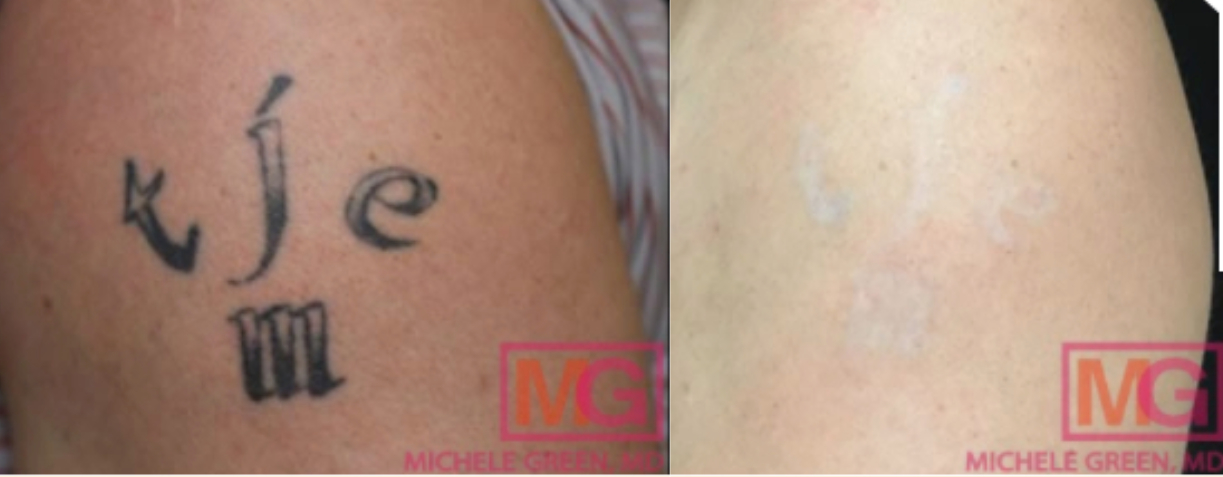
AlexTrivantage laser for tattoo removal, 8 treatments
Laser Tattoo Removal Treatments – AlexTriVantage
The most popular and safest laser is called the Q-switched laser, a gold standard in laser tattoo removal. The Q-switched laser is a high-intensity pulsed beam light that pushes the laser into the skin in short bursts of energy. When the laser is delivered on the skin, the pigment absorbs the energy of the laser which is then converted to heat. Chemical bonds in the pigment break down and small pigment particles are removed from the skin through blood vessels and the lymphatic system.
The Candela Alex TriVantage® is a unique Q-switched laser/nd-YAG that is gentle and safe for all skin types, including darker skin and Asian skin. One of the advantages of this laser is that it can remove tattoos with different colors of ink without damaging the surrounding skin. Alex TriVantage removes tattoo ink safely and effectively, with minimal discomfort. Blue and green inks are known for their stubbornness during tattoo removal, but Alex TriVantage can break down even blues and greens. The Alex-TriVantage can be used for tattoo removal on all areas of the body, including the face, neck, arms, legs, and back. The same laser technology is also effective at removing pigmented lesions, brown spots, sun spots, and age spots from the face and body.
Laser Tattoo Removal – FAQs
What does laser tattoo removal look like after?
Immediately following the laser treatment, there may be a “frosting” effect that gives the skin a chalky appearance. This is a safe and normal part of laser tattoo removal, and it occurs because the heat from the laser causes carbon dioxide to release from the skin. This is an expected, temporary reaction and may last only a few minutes up to half an hour. The treated site may experience swelling and redness, which typically lasts a few hours. Minor blistering and itching, as well as raised areas, are common and expected after treatment. The skin may feel tender and sensitive as well. These are signs of the skin’s natural healing processes and typically last up to two weeks.
The healing process can be elongated if the treated site is scratched or the blisters are formed. Scratching and picking cause trauma to the skin, delaying the skin from healing completely. This can also increase the risk of infection or permanent scarring. Laser tattoo removal makes your skin photosensitive, which means it is very important to limit sun exposure on the treated area. Wear protective clothing over the treated areas and apply sunscreen with a SPF 50 on the treatment sites in between sessions to prevent hyperpigmentation. Be sure to reapply the sunscreen every 90 minutes if you are exposed to the sun for a prolonged time and have the treatment area covered.
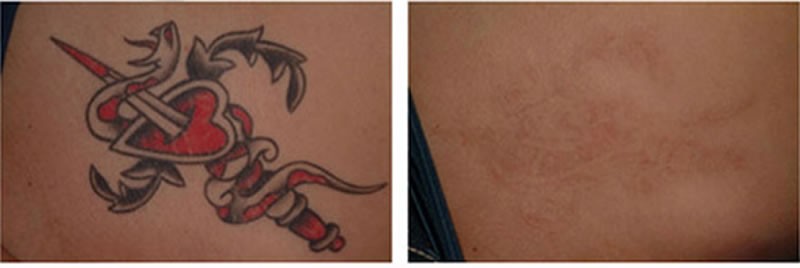
Before and After Photo, Laser Tattoo Removal
How effective is laser tattoo removal?
Modern lasers for tattoo removal are considered one of the most effective treatments to remove unwanted tattoos with relatively painless and quick recovery time. A benefit of laser tattoo removal is that it will not affect the surrounding skin, and will only target specific tattoo ink pigments. Today’s laser technology allows for complete removal of the tattoo, regardless of tattoo color and skin type, with fewer treatments, relatively short downtime, and minimal discomfort. The results of laser tattoo removal and how many sessions are needed depend on a variety of factors including the size of the tattoo, age, color, depth of the tattoo, and the amount of ink, as well as the general skin condition and type.
Can laser tattoo removal completely remove a tattoo?
The advanced laser technology today allows for complete tattoo removal, including tattoos of various colors. Darker-colored tattoos can easily be removed completely through laser tattoo removals. Black and blue ink tend to respond well to laser treatment due to their ability to absorb a wide range of wavelengths of light. In previous years, lasers were not able to effectively remove colored ink was hard to remove. This was based on that laser tattoo removal was similar to laser hair removal, in which the laser only detected dark colors like black. With the technological advancements in lasers, this is not an accurate statement anymore. Lasers like Alex TriVantage can target all different colors of tattoo ink. It is important to note that not all tattoos can be removed completely because tattoo ink is comprised of a variety of organic and inorganic ingredients that the provider is unable to detect prior to treatment.
Is laser tattoo removal safe?
Yes! Laser tattoo removal has been proven to be safe and effective through various clinical studies. The lasers used for tattoo removal, like Alex TriVantage, are approved by the Food and Drug Administration (FDA). This means that laser tattoo removal was tested in many clinical studies and deemed safe and effective for tattoo removal. The laser devices should be operated by a trained health care professional. An institution such as a MedSpa may offer free consultations and specials for subscribers, but seeking treatment from a MedSpa or similar institution can increase your risk for developing serious side effects. An experienced, board-certified dermatologist like Dr. Green will be able to adjust the treatment to your comfort level.
Does tattoo removal hurt?
Most patients can resume daily activities after laser tattoo removal treatment. Laser tattoo removal can be uncomfortable, and the severity of the pain depends on the individual’s general pain tolerance. Topical anesthetic cream is applied beforehand to minimize any discomfort throughout the procedure. Many patients reported that the pain level during laser tattoo removal is comparable to getting the tattoo.
There may be some discomfort remaining after the treatment, as your skin undergoes a natural healing process. It may feel like a mild sunburn that only hurts when it is rubbed against. Blistering can occur on treated sites which must be covered and bandaged for a few days. Blistering is a natural part of skin regeneration, as it progresses to scabbing, peeling, then healing.
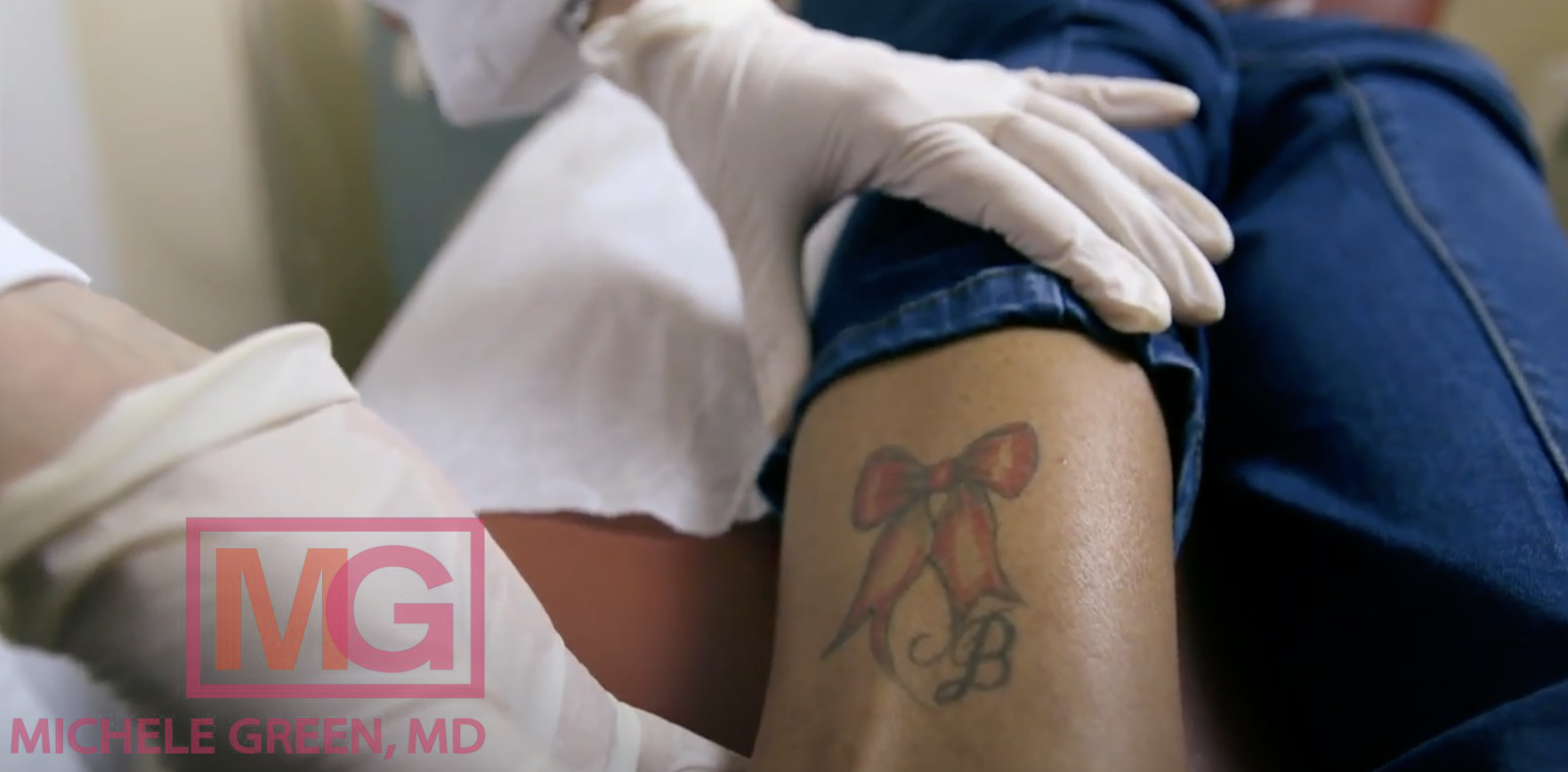
What does laser tattoo removal feel like?
Patients describe the sensation of laser tattoo removal as rubber bands snapping on the skin, followed by a feeling of warmth. The discomfort from the laser is temporary and tolerable. Many patients state that the pain level of laser tattoo removal is similar to that of getting the tattoo. With the application of topical numbing cream, the pain is minimized during the treatment.
How painful is laser tattoo removal?
Most patients agree that laser tattoo removal is only mildly painful or uncomfortable. The procedure can sting slightly where the laser is applied to the skin, however, before undergoing the laser treatment, Dr. Green’s office will prescribe a topical numbing cream to minimize potential discomfort or inject the area with lidocaine if needed. In the days following the treatment, patients may experience swelling and redness as well as some blistering. It is best to care for the treatment area by keeping it moisturized with Aquaphor or Vaseline to reduce discomfort while healing.
How long after laser tattoo removal will the tattoo fade?
Unfortunately, laser tattoo removal will not produce optimal results overnight. Multiple treatments are necessary to break down the ink in the skin layer by layer. Then, your immune system carries the broken down ink particles and filters them out of the body through the liver. With each laser session, the tattoo should progressively become lighter each week as the white blood cells continue to carry away the ink from the tattoo. Results may be seen around the third session, although it varies in each individual. Because laser tattoo removal also depends on your immune system, the overall health of your immune system can play a major role in how fast the body can eliminate the ink particles broken down by the laser light.
How long does laser tattoo removal take?
Unlike getting a tattoo which is a tedious process that can take anywhere from a few minutes to multiple hours, laser tattoo removal treatments are relatively quick, depending on the size and colors of the tattoo. Generally, each session takes about 15 minutes on average and does not hinder daily activities, making it a convenient procedure to have done on your lunch break. If the tattoo is bigger in size, each treatment session will last longer. Laser tattoo removal is a gradual process, so multiple treatments are needed to achieve the final, desired result.
How many laser tattoo removal sessions needed to remove the tattoo?
Laser tattoo removal can be a time-consuming process. The number of treatments will depend on the age, size, depth, and colors of the tattoo, as well as your skin type. It can take six to twelve treatments to remove some multi-colored tattoos. It is not feasible to predict exactly how many treatments will be needed for specific tattoo removal due to the variations in ink chemical compositions and tattoo colors utilized by tattoo artists today. Furthermore, amateur black tattoos are removed more easily than professional tattoos. Amateur tattoos typically consist of one color called India ink, where professional tattoos use multiple colors. Furthermore, the depth of the ink deposited into the skin varies in amateur tattoos, ranging from epidermis (the outermost layer of the skin) to dermis (the deeper layer of the skin). In professional tattoos, the ink is uniformly deposited into the dermis. Laser tattoo removal is a gradual process, as the laser shatters the tattoo ink layer by layer, and you do not want scarring from an aggressive laser treatment. Consult with Dr. Michele Green, an experienced, board-certified dermatologist based in New York, to discuss the number of treatment sessions necessary to remove your specific tattoo.
What to expect after laser tattoo removal
Laser tattoo removal is a safe and effective treatment with minimal discomfort and downtime following the procedure. Some patients may experience mild, common side effects, including redness, swelling, bruising, blistering, and scabbing, but these effects should subside on their own within a week. After each subsequent treatment, common side effects should diminish in severity. Directly following the procedure, patients can resume regular activities but should be advised to keep the treatment area wrapped in gauze and bandaged for three days. Strict sun avoidance is also recommended in order to protect the treatment area, which will be more susceptible to photo-damage throughout the treatment process. When discussing your treatment plan, Dr. Green’s office will also be able to provide full aftercare instructions.
Can I shower after laser tattoo removal?
In the three days following the laser tattoo removal treatment, you will be instructed to bandage the treatment area and keep it dry. After the bandage is removed, you can shower and clean the treatment area. Dr. Green recommends washing the treatment area with a gentle cleanser and patting the area dry so as not to irritate the skin. We recommended keeping the treated area covered for at least one week after laser. It is also important to avoid soaking the area throughout the treatment process, which means staying away from baths, hot tubs, and swimming pools.
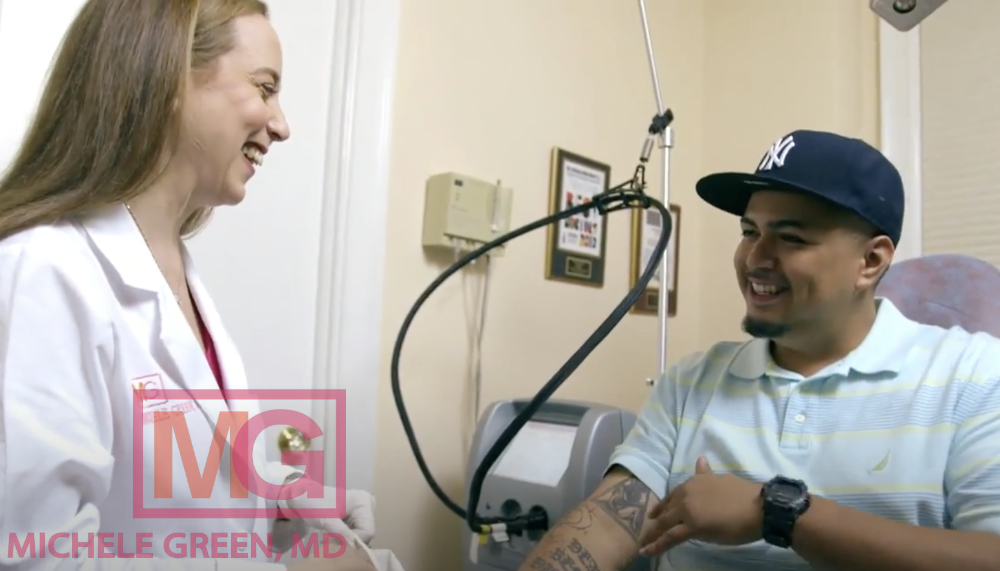
Does tattoo removal damage skin?
Laser tattoo removal works to eliminate the pigmentation of tattoos in the skin while leaving the surrounding tissue unharmed. Generally, side effects of laser tattoo removal are mild and resolve themselves within a week after receiving the treatment. These mild side effects include, redness, swelling, bruising, and blistering, though blistering can worsen if patients pick at the scabbing skin. In very rare cases, some patients have experienced additional scarring as a result of laser tattoo removal or hyperpigmentation at the treatment area. The risk of developing serious side effects is greatly reduced if you seek treatment from an expert, board-certified dermatologist, such as Dr. Michele Green in NYC.
Does laser tattoo removal leave a scar?
The lasers used in tattoo removal typically usually do not leave scars. However, there is a small chance of scarring from laser tattoo removal, especially if the treated site is not taken care of properly. During the skin’s natural healing process, cover the treated area with bandage if you experience blisters. Avoid excessively rubbing the skin to let the skin heal. After a shower or a bath, gently pat the area dry with a towel instead of rubbing it. It is important to keep the treated area is clean because the site is more susceptible to infection. Avoid picking at the scabs that form because that will cause trauma to the skin and prevent healing. Protecting the treated site from the sun is important to avoid scarring. The laser should be performed by a trained dermatologist who is an expert in laser tattoo removal to minimize the risk of scarring and other side effects. Be sure to inform Dr. Green if you have a history of abnormal scarring or keloids.
Does laser tattoo removal cause cancer?
The Skin Cancer Foundation has concluded that laser tattoo removal does not cause skin cancer. However, laser tattoo removal does makes the skin photosensitive, or more sensitive to the sun’s harmful UV rays. This increases the risk of sun damage and skin cancer after laser treatment. These risks can be significantly decreased with sunscreen application and reapplication as well as avoiding sun exposure through protective clothing and accessories like an umbrella. Furthermore, there is no evidence that tattoo ink pigments are related to skin cancer or lymphoma. Someone with tattoos has no higher risk of cancer than someone without tattoos.
Can laser tattoo removal cause nerve damage?
No. Laser tattoo removal does not cause nerve damage if performed by a trained and experienced physician. The laser only penetrates the skin to shatter the tattoo ink pigment. It does not penetrate deep enough to affect the nerves under the skin. Therefore, it will also not affect the underlying structures such as muscles, tendons, ligaments, and bones. If you are a musician and require your fine motor skills to be in tact, do not worry. Laser tattoo removal will not affect your nerves or motor skills if done safely by a board-certified dermatologist. Those undergoing laser tattoo removal can resume daily activities immediately after treatment, and the treatment is very quick, making it a great lunch break procedure for those with busy lifestyles.
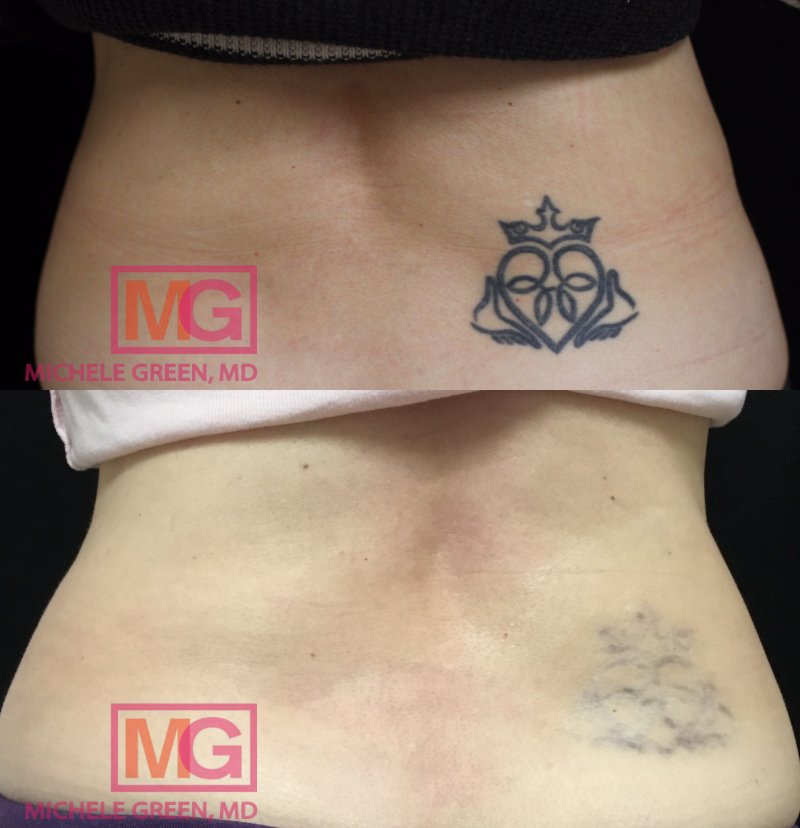
Laser Tattoo removal – before and after 8 sessions
Can you get laser tattoo removal while pregnant?
Laser tattoo removal is not advised for patients who are pregnant or breastfeeding. The effects of the laser pigmentation removal treatment have not been tested on pregnant and/or breastfeeding women, and for that reason there is very little data about the effects of the treatment on the fetus or baby.
Can you tattoo over laser tattoo removal?
Once the treatment area has healed, yes, you can tattoo over an area that you treated and the tattoo removed by laser. Dr. Green recommends waiting for at least six weeks after your last laser tattoo removal treatment before booking an appointment for a new tattoo. It is important to give time for the area to heal and for your immune system to settle before getting a new tattoo in order to protect the new ink in the treatment area and have the best results. It is best to inform your tattoo artist about your recent laser tattoo removal treatment and they can also make a recommendation on the ideal timeline for receiving new ink.
How much is laser tattoo removal?
The cost of laser tattoo removal depends on the size, location, color, and age of the tattoo. The price of laser tattoo removal for small tattoos are less than that of larger tattoos. On average, each laser tattoo removal session costs around $600. Generally, the cost of cosmetic procedures may depend on the geographic location, the expertise of the technician or physician, and the type of laser used. Consult with a board-certified dermatologist like Dr. Green to discuss the pricing plan for your specific tattoo removal needs. Currently, laser tattoo removals are considered a cosmetic procedure by insurance companies. Therefore, it will not be covered under health insurance benefits.
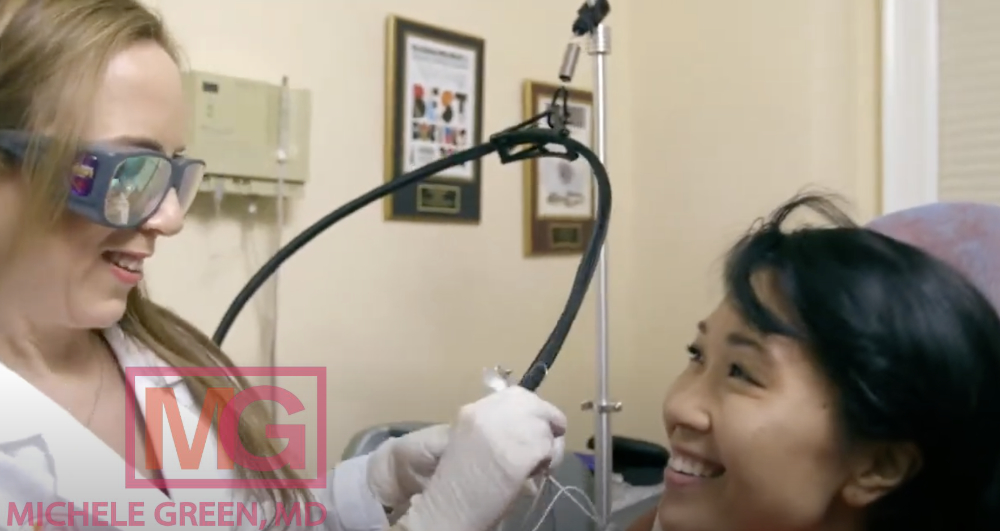
Does laser tattoo removal work?
Yes! Laser tattoo removal treatment is a safe and effective way to eliminate an unwanted tattoo with minimal discomfort and downtime. The treatment uses laser technology to break down the pigmentation in the deep layers of the skin so that your immune system can metabolize the pigment and reduce the appearance of the tattoo. By triggering the body’s own metabolic processes, laser tattoo removal is much less invasive than older methods of tattoo removal but no less effective. For the best results, patients will need a series of treatment sessions in order to fully remove the tattoo. Patients will consult with expert dermatologist, Dr. Green, to create the treatment plan that is best to suit their aesthetic goals.
How can I get started with removing an unwanted tattoo?
An unwanted tattoo can be a great annoyance and, for many, may even cause feelings of self-consciousness. If you have an unwanted tattoo that no longer reflects who you are, has a negative association that you’d like to forget, or is no longer cosmetically appealing, laser tattoo removal may be the solution for you. Additionally, many tattoo artists will ask that you have an old tattoo faded with laser tattoo removal before they do a cover-up tattoo. It is important that the type of laser used for your laser tattoo removal is appropriate for your skin type and skin tone in order to avoid unwanted or dangerous side effects. To develop a safe and effective treatment plan for diminishing the appearance of your unwanted tattoo, it is always recommended to consult with an expert board-certified dermatologist, like Dr. Green in New York City.
Dr. Michele Green is an internationally renowned leader in the field of cosmetic dermatology with over 25 years of experience providing her patients from around the globe with the best non-invasive rejuvenation treatments available, including laser tattoo removal. Castle Connolly, New York Magazine, and Super Doctors consistently identify Dr. Green as one of New York City’s best physicians for her dedication to her expertise. Utilizing the most cutting-edge laser technology and innovative treatment techniques, Dr. Green has helped countless individuals to look and feel like the best version of themselves. To get started with removing an unwanted tattoo with laser tattoo removal, schedule a consultation with Dr. Green by contacting us online or calling the NYC-based office at 212-535-3088.
Am I a Candidate for Laser Tattoo Removal?
Find out more about Laser Tattoo options available to you
 212-535-3088
212-535-3088